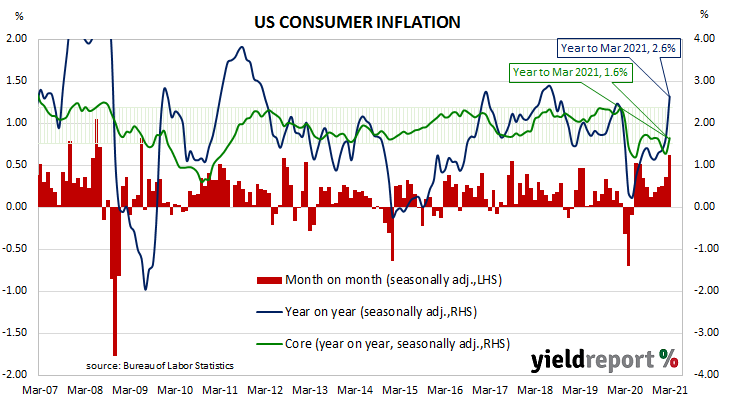Summary: US CPI up solidly in March; just above expectations; “core” rate up, slightly more than expected; “early signs” of firming inflation components; headline rate again driven by higher fuel prices; financial markets “embracing” Fed rationale of “transitory effects”; New York Fed measure above 2%.
The annual rate of US inflation as measured by changes in the consumer price index (CPI) halved from nearly 3% in the period from July 2018 to February 2019. It then fluctuated in a range from 1.5% to 2.0% through 2019 before rising above 2.0% in the final months of that year. Substantially lower rates were reported from March 2020 to May 2020 but subsequent reports indicated consumer inflation has largely returned to pre-pandemic levels.
The latest CPI figures released by the Bureau of Labor Statistics indicated seasonally-adjusted consumer prices rose by 0.6% on average in March. The result was slightly above the 0.5% increase which had been generally expected and double February’s revised increase of 0.3%. On a 12-month basis, the inflation rate accelerated from February’s reading of 1.7% to 2.6%.

“Headline” inflation is known to be volatile and so references are often made to “core” inflation for analytical purposes. Core inflation, a measure of inflation which strips out the volatile food and energy components of the index, increased by 0.3% on a seasonally-adjusted basis for the month. The result was more than the expected 0.2% and higher than February’s 0.1% increase. The annual rate accelerated after slowing in the previous two months, rising from 1.3% to 1.6%.
“There are thus some early signs of a firming in key inflation components, but it will require more than one month’s data for markets to react. For now, the Fed will be relaxed as the inflation spike is within their forecast profile,” said ANZ economist Adelaide Timbrell.
US Treasury bond yields lost ground on the day. By the close of business, the 2-year yield had slipped 1bp to 0.15%, the 10-year yield had shed 5bps to 1.62% while the 30-year yield finished 4bps lower at 2.30%.
In terms of US Fed policy, expectations of any change in the federal funds range over the next 12 months remained fairly soft. April 2022 futures contracts implied an effective federal funds rate of 0.10%, a few basis points above the spot rate.

